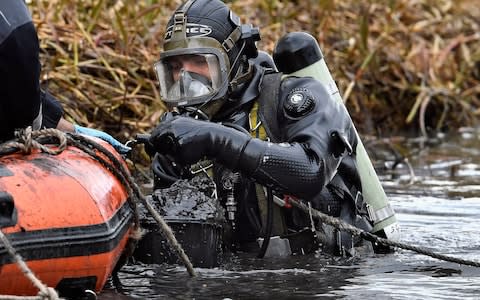Fluorescent lights to help police divers find human remains

Fluorescent light technology is being developed to help police officers find human remains in lakes, ponds and rivers.
Researchers at the University of Huddersfield are trying to exploit the natural fluorescence of human bones through different light sources - using coloured filters - so they glow and become visible to forensic teams during land and water searches.
They believe the presence of the protein, collagen affects how fluorescent bones are under different wavelengths of light and are working on a standardised method that could be adopted by investigators.
It could mean something as simple as a new flashlight for detectives or forensic teams so they can sift through masses of spoil at a scene - without missing traces of bone, which can sometimes be confused with stones and go uncollected.
Meanwhile, underwater the method could even lend itself to remotely operated underwater vehicles (ROVs), during body searches. “So many people drown or go missing in water”, said Dr Anna Williams who is mentoring PHD student, Catherine Maidment, on the project.
“And we don’t have as good an armoury of techniques to find bodies in water as we do on land.
“We want to be able to go to a river or a lake, or a pond and say ‘now we need to use this particular combination of light and filter to find the body parts in this kind of water.”

Bodies can begin to skeletonize within just weeks of death in exposed areas. Initial tests at the university are already proving positive using a 450 nanometers light (blue light) with yellow and orange filters applied to the bones of pigs.
Once a technique is perfected for land, scientists will have a better idea of what can work in water and will set about examining the best solutions at different depths, temperature, colour, salinity (salt levels) and murkiness/dirt of water.
“There are a lot of different variables to look at,” Miss Maidment, 30, said. “We need to test this in all types of water.”
Drowning is one of the lead causes of accidental death in the UK each year, with up to 400 deaths, according to the Royal Life Saving Society.
In 2016 drowning accounted for up to 278 deaths, a similar figure to the amount of people killed in house fires. However the technology would also lend itself to people killed as a result of criminal activity and those who commit suicide in water.

Dr Williams sits alongside 14 other academics on the Home Office’s Search Technology Research Team (START), who assist the police and home office with their expertise and findings.
The method has been touched upon briefly by FBI Studies in the past, but for the first time this research involves measuring the amount of collagen present in different bones - to check whether this correlates to the quality of ‘a glow’ - and examining how light sources can be adapted to expose this in the best way, under different circumstances.
Dr Williams, a forensic anthropologist, said although collagen decreases overtime in bones, there have been instances where it continues to remain present, even in archeological finds.
This means the technique could be applied to searches for people who have been missing for decades, and even longer.
Up until now, alternative light sources have been restricted to helping forensic teams expose human saliva, sperm, vaginal tissue or blood at crime scenes, so they can narrow down specific locations for DNA collection, say in a room.
Those fluids are also naturally fluorescent.
Currently police diver teams use sonar radar to scan water for bodies, but this relies on finding full human cadavers - which are indicated by their large size.
Finding skeletal remains however, remains trickier, as they often become damaged, fragmented and dispersed - on land and in water.

 Yahoo News
Yahoo News 
